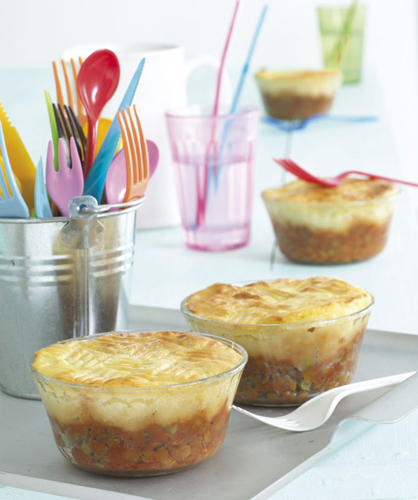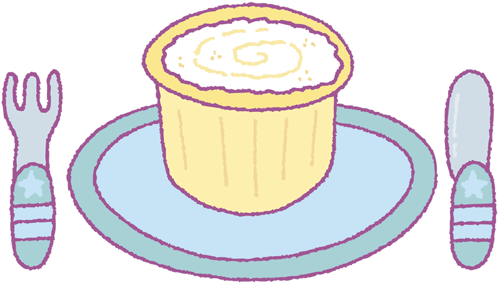Whether your toddler is allergic or has a specific diet for lifestyle or religious reasons, it is perfectly possible to present healthy, balanced meals. As long as you know where the potential nutritional shortfalls may be, you’ll have the knowledge you need to substitute from a cornucopia of goodies.
| Q: |
Are there any meat substitutes that I can buy?
| | A: |
You can buy textured vegetable protein (TVP), which is soy flour
that’s been processed and dried. It’s available ground into granules
that resemble minced beef and is prepared by mixing with vegetable stock
and then leaving it to stand for a few minutes. It is great for making
bolognese or burgers. As well as being a good source of protein, it is
fortified with vitamin B12, which vegetarian or vegan diets sometimes
lack.
|
| Q: |
How can I make my toddler’s vegetarian menu a little more exciting?
| | A: |
Vegetarian diets vary dramatically, with some vegetarians eating
fish, eggs, and milk, and some cutting them out alongside meat and
poultry. As long as you take care to ensure that your toddler gets the
nutrients she’d normally get from eating these foods—iron, vitamin B12,
protein, and zinc—anything goes.
Consider adding dairy
products, ground seeds and nuts, as well as plenty of pulses, such as
chickpeas, lentils, and beans, to ensure she has adequate protein in her
diet. Tofu (made from soy bean curd) doesn’t have much taste, but if
you marinate it, you can use it to make tasty stir fries. With children
under the age of five, you should stick to nut butters and ground or
finely chopped nuts due to the choking risk. Ground almonds make a tasty
addition to cakes and crumbles. Eggs will add protein and some iron, as
will fortified breakfast cereals, whole wheat bread, dried fruits,
leafy green vegetables, and lentils. Most of these supply zinc, too.
Vitamin B12 is adequately represented in dairy products, fortified
breakfast cereals, and eggs. You can then experiment with different
herbs, spices, and other flavors .
|
| Q: |
What grains are a good addition to a vegan diet?
| | A: |
The key is to provide variety, so the greater the number of
grains you manage to include in your toddler’s diet, the more nutrients
he will be getting.
Good choices are quinoa,
buckwheat (which can replace flour in most recipes), oats, corn (on its
own, or in a tortilla, pasta, or even bread), wheat, wild rice, rye,
brown rice, and amaranth are all worth trying, either in baking or as an
addition to a healthy meal.
|
| Q: |
What can I use instead of eggs in my allergic toddler’s diet?
| | A: |
Eggs are a good source of protein, and contain mainly vitamins A,
D, and E. While eggs are not essential, you will need to ensure that
your toddler gets protein from other sources, such as pulses, whole
grains, meat and fish, seeds, soy, and dairy products.
Although nuts are a
good source of protein, around 20–30 percent of egg allergics have nut
allergies. Multiple allergies do often rule many of these foods out, so
you will need the help of a dietitian to make sure your toddler’s needs
are met. A diet that is rich in fresh fruits and vegetables will supply
adequate vitamins and minerals, and making sure that your toddler gets
plenty of whole grains (see Culinary adventures) will keep her B vitamin levels topped off.
If you are baking,
there are some good “egg replacements” on the market, although these
will not have the same nutritional benefits as real eggs. If you are
stumped for breakfast ideas, consider tofu scramble, which is a good,
healthy alternative that I like to make.
|
| Q: |
How can I incorporate pulses into my toddler’s vegetarian diet?
| | A: |
On their own, most pulses are fairly bland, which makes them
ideal for adding to almost any dish. A handful of cooked lentils,
chickpeas, butter beans, kidney beans, or soy beans can be added to
pasta dishes, vegetables bakes, and casseroles. They can often form the
basis of meals, too, as in the Vegetarian shepherd’s pie recipe,
which uses lentils instead of meat. Chickpeas can be added to couscous
for a cold or hot main meal, along with chopped onions, feta cheese, and
some diced tomatoes. Purée chickpeas or even butter beans with some
tahini, lemon juice, and garlic to make a healthy hummus to spread on
toast. Try mashing butter beans with a little vegetarian stock as an
alternative to mashed potatoes.
|
Quinoa quota
One of the very best
foods you can offer a vegan toddler is quinoa. This looks like a grain
but is, in fact, a seed. It is rich in essential fatty acids, protein,
iron, fiber, and antioxidants. It can be used in much the same way as
couscous, or can be added to soups, stews, casseroles, pasta dishes, and
risottos.
Culinary adventures
Having a child with
special dietary needs may force you to become a little more creative in
your cooking, and to experiment with foods with which you may not be
familiar. However, in the long run, your whole family will benefit from
the wealth of new ingredients you explore, and will undoubtedly become
more adventurous eaters, as a result.
Vegetarian Shepherd’s Pie
Lentils are a good source of protein and iron for vegetarians, and green lentils in a tomato sauce makes a savory and satisfying filling for these little potato-topped pies.


10 minutes
1 hour 35 minutes
1 tbsp olive oil 1 red onion, finely chopped 1 carrot, peeled and grated 1 garlic clove, crushed 3/4 cup green lentils, rinsed 14oz can crushed tomatoes 21/2 cups vegetable stock 2/3 cup water 2 tbsp tomato paste 1 tbsp soy sauce 1 tbsp light brown sugar Freshly ground black pepper 1/3 cup frozen green peas (optional) Topping
Heat the oil in a large
saucepan and sauté the onions and carrots until softened and lightly
browned. Add the garlic and cook for 1 minute. Stir in the lentils,
tomatoes, stock, water, tomato paste, soy sauce, and sugar. Bring to a
boil, then reduce the heat, partially cover, and simmer until the
lentils are tender, about 1 hour.
Meanwhile, cook the
potatoes in lightly salted boiling water until tender, about 15
minutes. Drain, then mash well with the butter and milk.
Season the lentils to
taste with pepper and stir in the peas, if using. Divide among four to
six ramekins or other small baking dishes. Spread the mashed potatoes
over the lentils and mark ridges with a fork. Cool, then refrigerate.
Or, cover with plastic wrap and freeze; thaw overnight in the
refrigerator when needed.
To cook, preheat the
oven to 400°F. Put the pies on a baking sheet, brush the tops with
beaten egg (or sprinkle with cheese), and bake until golden and piping
hot, about 30 minutes. Let cool slightly and check the temperature
before serving.
|